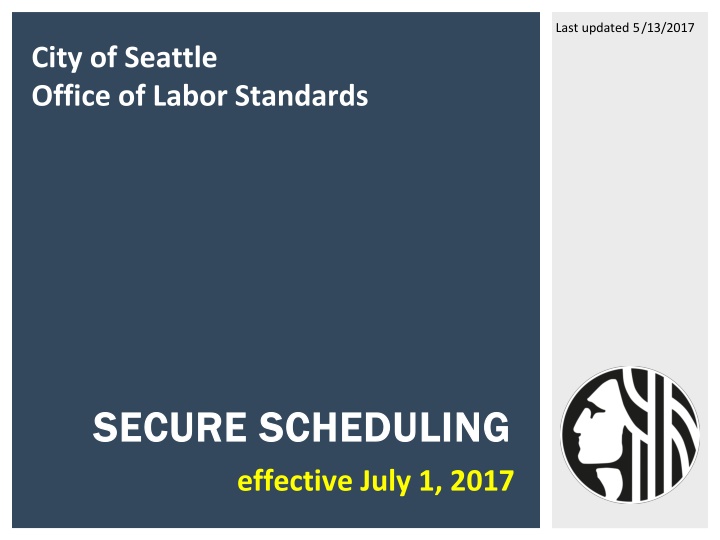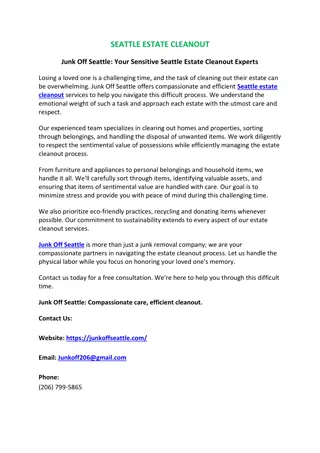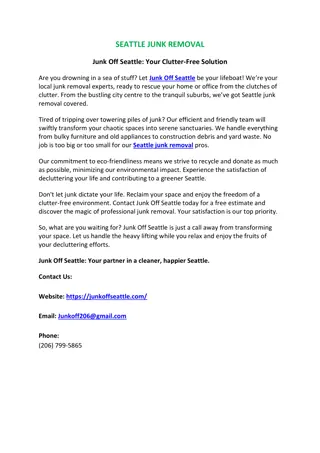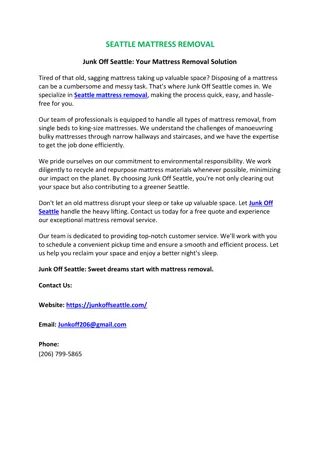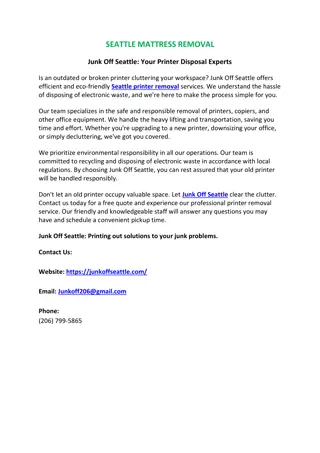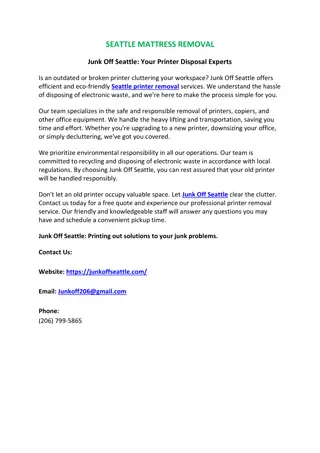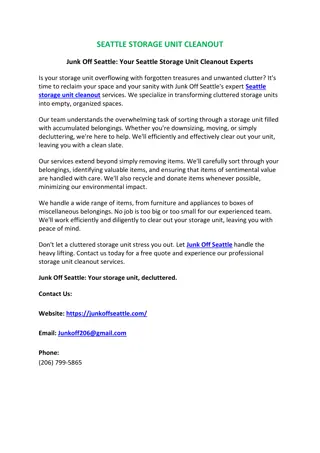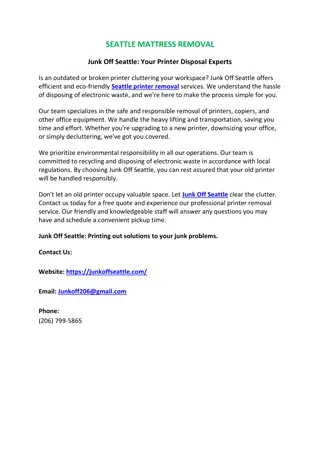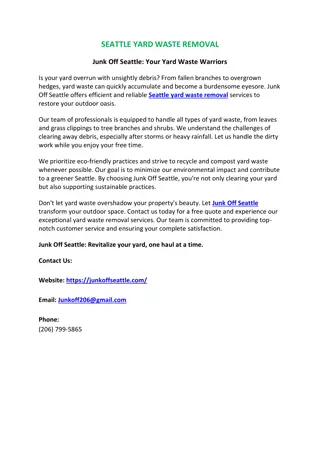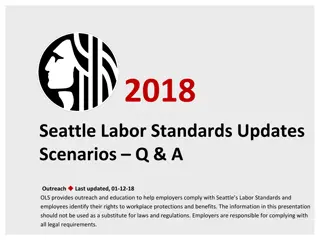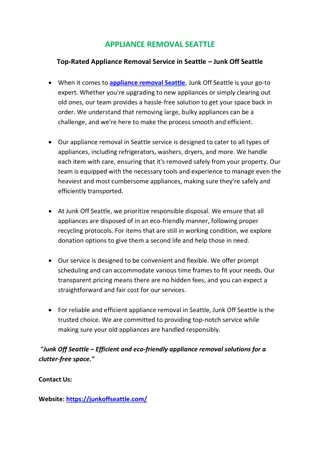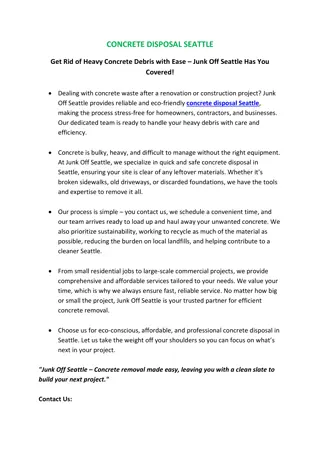Office of Labor Standards in Seattle: Mission, History, and Staff Overview
The Office of Labor Standards (OLS) in Seattle is dedicated to promoting labor standards through community and business engagement, enforcement, and policy development with a focus on racial and social justice. Established in 2012, OLS has implemented various ordinances to protect workers' rights, such as the Secure Scheduling Ordinance. The office has a dedicated staff led by Director Dylan Orr and continues to grow its team to enhance its impact.
Download Presentation

Please find below an Image/Link to download the presentation.
The content on the website is provided AS IS for your information and personal use only. It may not be sold, licensed, or shared on other websites without obtaining consent from the author.If you encounter any issues during the download, it is possible that the publisher has removed the file from their server.
You are allowed to download the files provided on this website for personal or commercial use, subject to the condition that they are used lawfully. All files are the property of their respective owners.
The content on the website is provided AS IS for your information and personal use only. It may not be sold, licensed, or shared on other websites without obtaining consent from the author.
E N D
Presentation Transcript
Last updated 5/13/2017 City of Seattle Office of Labor Standards SECURE SCHEDULING SECURE SCHEDULING effective July 1, 2017
OLS MISSION Our mission is to advance labor standards through thoughtful community and business engagement, strategic enforcement and innovative policy development, with a commitment to race and social justice.
OLS HISTORY 2012 PSST - Paid Sick and Safe Time Ordinance 2013 FCE - Fair Chance Employment Ordinance 2014 Mayor convened Income Inequality Advisory Committee to craft minimum wage policies Mayor and City Council convened Labor Standards Advisory Group to address wage theft and suggest ways to strengthen labor standards implementation City Council passed legislation creating Office of Labor Standards as a new division within the Seattle Office for Civil Rights April 1, 2015 OLS birthday MW & WT - Minimum Wage and Wage Theft Ordinances 2016 Wage Theft Prevention and Labor Standards Harmonization Ordinance HEHS - Hotel Employees Health and Safety Initiative 2017 OLS becomes an independent office SS - Secure Scheduling Ordinance
OLS STAFF May 2017 - 17 Core Staff Dylan Orr, Director Senior Policy Advisor Communications Manager Finance Operations Manager 2 Business Liaisons Community Liaison Enforcement Supervisor 6 Investigators Intake investigator Paralegal Administrative Assistant Spring 2017 OLS will move into a new office on the third floor, 810 3rdAvenue OLS will hire 5 additional staff by the end of 2017 Policy & data analyst, three investigators, admin assistant
BUSINESS QUESTIONS Darius Foster, Business Liaison 206-386-1238 Darius.foster@seattle.gov Kerem Levitas, Business Liaison 206-386-9758 Kerem.levitas@seattle.gov Karina Bull, Senior Policy Advisor 206-684-4536 Karina.bull@seattle.gov
OLS MONTHLY DASHBOARDS
OLS MONTHLY DASHBOARDS Information compiled from 2012 to present Monthly compilations from June 2015 to present http://www.seattle.gov/laborstandards/data
MARCH 2017 - DASHBOARD Employee Inquiries / total Employer Inquiries / total 1,44 1 3,965 1,412 468 397 314 128 219 PSST FCE WT MW PSST FCE WT MW
MARCH 2017 - DASHBOARD Employer Inquiries / March Employee Inquiries / March 34 26 36 16 15 15 7 2 1 14 1 PSST FCE WT MW
MARCH 2017 - DASHBOARD Investigations opened Total Investigations closed Total 230 151 133 97 79 78 31 20 PSST FCE WT MW PSST FCE WT MW
MARCH 2017 - DASHBOARD Monetary remedies assessed (wages, interest, and damages) Investigations open March 79 PSST $180,992.53 55 FCE $23,000 WT $24,252.32 18 11 MW $781,667.02 Total $1,009,911.87 PSST FCE WT MW Total Number of Employees Awarded Monetary Remedies 1,241
SECURE SCHEDULING SECURE SCHEDULING effective July 1, 2017
Predictable schedules that work. New secure scheduling practices for Race & social justice Employee health, safety and welfare Greater economic security Increased employee input into scheduling; and Reduced involuntary part-time work.
LARGE FOOD SERVICES & RETAIL Large food service & retail employers Retail = 2012 NAICS code 441-453998 Food Service = 2012 NAICS code 722 500+ employees worldwide Full Service Restaurants = additional requirement for 40+ full-service restaurant locations worldwide NAICS Code = North American Industry Classification System Employers must list the NAICS code when registering for a City of Seattle business license.
NAICS CODE http://www.seattle.gov/licenses/find http://www.seattle.gov/licenses/find- -a a- -business business
SCHEDULING REQUIREMENTS 1. Good faith estimate of work schedule 2. Right to request input into work schedule 3. Right to rest between work shifts 4. Advance notice of schedule 5. Compensation for schedule changes 6. Access to hours for existing employees
GOOD FAITH ESTIMATE Employer provides written estimate of median number of hours and on-call shifts.
GOOD FAITH ESTIMATE 1. Employer provides written information - Median number of hours and whether employee will work on-call shifts over the course of one year (divided into three-month periods) New employees = at time of hire. Existing employees = revise once every year (calculated from the point of the last good faith estimate) and when there is a significant change. Translations required = must be provided in English and primary language of the employee.
GOOD FAITH ESTIMATE 2. Employee can notify employer of a significant change. Significant change = difference of at least 30% between the GFE and median number of scheduled hours in written work schedules, over the one or more three-month periods. 3. Upon notification of a significant change, employer must initiate an interactive process with employee. 4. Employer must complete interactive process within three weeks.
EXAMPLE GOOD FAITH ESTIMATE 1. Hire date: January 1, 2017 2. Median number of hours over the course of the year Year begins January 2017 Quarter One (January March) 20 hours Quarter Two (April June) 20 hours Quarter Three (July September) 20 hours Quarter Four (October December) 35 hours 3. On-call shifts Yes No
EXAMPLES 30% SIGNIFICANT CHANGE Estimate Median Hours Significant Change: Adding Hours Significant Change: Subtracting Hours 40 30 20 10 52 39 26 13 28 21 14 7
RIGHT TO REQUEST Employee can request schedule preferences prior to posted work schedule.
RIGHT TO REQUEST 1. Employee can request work schedule preferences & changes Requests for specific times and locations of work. Employer must engage in interactive process Must initiate discussion within one week of the request; complete the discussion within three weeks. Employer can ask for verifying information Must inform employee of ability to redact private information. Written statement from employee or documentation from third party (e.g. health care professional, school, landlord). Employer has increased obligations for requests due to major life events Must grant request unless the employer has a bona fide business reason for denying such request. Must provide a written response when granting or denying the request. 2. 3. 4.
MAJOR LIFE EVENT Employer has increased obligations for employee- requests for schedule changes due to a major life event.
MAJOR LIFE EVENT Important, serious or significant event related to the employee's access to the workplace due to Changes in employee's transportation. Changes in employee s housing. Employee's own serious health condition. Employee's responsibilities as a caregiver. Employee's enrollment in a career-related educational or training program. Employee's other job or jobs.
BONA FIDE BUSINESS REASON Employer can identify a bona fide business reason to decline an employee s request for work schedule preferences related to a major life event.
BONA FIDE BUSINESS REASON Significant & identifiable burden of additional costs. Significant & identifiable detrimental effect on ability to meet organizational demands A work schedule change that requires an employer to pay additional compensation under a law or written policy (e.g. holiday pay). An action causing employer to violate a bona fide collective bargaining agreement or a seniority system in a written policy; An action causing the employer to displace one or more employee(s) from an existing work schedule arrangement.
RIGHT TO REST Employer pays additional compensation for clopenings separated by less than 10 hours
RIGHT TO REST 1. Clopening - Employee works closing and opening work shifts. 2. Employee request or consent - Employer only schedules clopenings separated by less than 10 hours upon employee request or consent. 3. Additional pay (i.e. premium pay ) - Employer pays 1.5x the scheduled rate of pay for hours worked that are less than ten hours apart. 4. Exception - Additional compensation does not apply to split shifts
ADVANCE NOTICE OF WORK SCHEDULE Employer provides work schedule 14 days in advance.
EXCEPTIONS ADVANCE NOTICE OF SCHEDULE Exceptions for new and returning employees Employees with a work schedule change. New employees at time of hire. Transfers, promotions, and new job classifications. Employees who are jointly employed (e.g. employees provided by a staffing agency, contractor, subcontractor, or other employer); and Returning employees from a leave of absence.
PAY FOR SCHEDULE CHANGES Employer provides additional pay for employer-requested schedule changes (with some exceptions).
PAY FOR SCHEDULE CHANGES 1. Compensation ( premium pay ) Adding hours = Employer pays one additional hour of pay at the scheduled rate plus wages earned. Employer may pro-rate payment for changes that are less than one hour. Subtracting hours (including on-call shifts) = Employer pays for half the hours not worked plus wages earned. 2. Grace period = 15 minutes
EXCEPTIONS PAY FOR SCHEDULE CHANGES Employer DOES NOT provide additional pay for certain schedule changes.
EXCEPTIONS PAY FOR SCHEDULE CHANGES 1. 2. Employee-requested changes Shift swaps - Manager can grant or deny employee requests for shift swaps. Mass communication - Employee accepts a schedule change in response to an employer-initiated, mass communication about availability of additional hours due to a scheduled employee not being able to work. In-person group communication - Employee accepts a schedule change in response to an employer-initiated, in- person group communication with two or more currently working employees about additional hours due to unanticipated customer needs. 3. 4.
EXCEPTIONS PAY FOR SCHEDULE CHANGES 5. Access to hours - Employee accepts an offer of hours under the access to hours provision. Discipline Employer reduces employee hours due to bona fide discipline. Operations cannot begin or continue Employer cannot begin or continue operations due to (a) threats to employees or property; (b) recommendation of public official; (c) public utilities failure; (d) natural disaster; (e) weather event; and (f) an event that would cause the employer to violate a law. 6. 7.
EXCEPTIONS PAY FOR SCHEDULE CHANGES Mass communication Employer-initiated, written message sent to two or more employees about availability of additional hours due to a scheduled employee not being able to work. 1. Required information - Each mass communication must convey The message is a mass communication; Accepting the offer of additional hours is voluntary and the employee has the right to decline such hours; and Accepting such hours does not require the employer to pay additional compensation for work schedule changes. 2. Scope - Employer may choose to limit mass communications to (a) qualified employees, and (b) employees who would not incur premium pay (e.g. overtime).
EXCEPTIONS COMPENSATION FOR SCHEDULE CHANGES In-person group communication Employer-initiated, discussion with two or more employees about availability of additional hours due to unanticipated customer needs. Hours must be consecutive to current shift. 1. Required information - Each in-person group communication must convey Accepting the offer of additional hours is voluntary and the employee has the right to decline such hours; and Accepting such hours does not require the employer to pay additional compensation for work schedule changes. 2. Scope - Employer can initiate the in-person group communication with currently working, qualified employees who are not already scheduled to work the additional hours.
ACCESS TO HOURS Before hiring new employees (including temps), employers must offer hours to current employees.
ACCESS TO HOURS Three + Two Days 1. Notice of Hours Three days - Employer posts written information about additional hours in noticeable place at worksite for all employees on the payroll 2. Job Offer Two Days - Employer offers job to qualified, existing employee(s) and allows two days to consider offer.
ACCESS TO HOURS NOTICE OF HOURS 1. Employer posts written notice for three days in conspicuous place at worksite Notice includes position description and title; required qualifications; total hours of work; schedule; and duration of assignment (temp or on-going). Notice may provide specific or general information (e.g. hours and schedule dependent upon the employee s availability ). 2. Employer provides notice to all employees on the payroll Employer is not required to provide notice to employees on a leave of absence, planned vacation, or planned use of PSST for the entire three-day period of notice.
ACCESS TO HOURS JOB OFFER 1. Employer offers job to qualified, existing employee(s) and allows two days to consider offer. Employer CANNOT not require one employee to accept all hours Employer CAN limit distribution of hours to full work shifts rather than parceling hours among employees.
ACCESS TO HOURS JOB OFFER 2. Employee may not qualify for the additional hours under the following circumstances Overtime = Overtime or predictability pay would be required if the employee received the additional hours. Discipline = Employee is not currently in good standing due to a bona fide employer documented discipline or improvement plan. Pre-emption = Employee is barred by other laws from conducting the work required in the available hours. Unqualified = Employee, to a reasonable employer acting in good faith is not qualified with the skills and experience to perform the work.
EXCEPTIONS - ACCESS TO HOURS Employer can immediately hire new employees in certain situations.
EXCEPTIONS - ACCESS TO HOURS 1. Written declination from all current employees 2. Written declination from employees on access to hours list(s) Access to hours list = Written list of employees who receive notice of additional hours available for work. All employees are automatically on the list & can ask to be added or removed at time of hire or during employment. Employer must make list available for viewing to employees upon request. 3. Hiring programs = Hours of work that the employer has designated for hiring programs (e.g. diversity, supported employment, young adult programs) affiliated with a government entity or external non-profit organization that has been approved subject to the rules of the Director.
OTHER REQUIREMENTS 1. Record keeping 2. Notice and posting 3. Protections against Retaliation 4. Waiver 5. Employees who are jointly employed
RECORD KEEPING Employers must keep records for three years.
